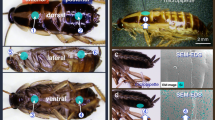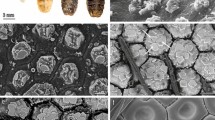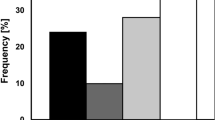Abstract
I HAVE recently had occasion to require a standard or repeatable degree of abrasion of the cuticle of an insect, the larva of Rhodnius 1. It was observed that in regions where excreta containing crystals of uric acid had dried on the surface, the cuticle appeared to be more permeable, suggesting that the drying of suspensions containing solid particles might produce abrasion. This was tested by applying suitable suspensions in distilled water, allowing them to dry in air, removing the particles in a stream of water and then testing for abrasion by exposure to ammoniacal silver hydroxide2.
This is a preview of subscription content, access via your institution
Access options
Subscribe to this journal
Receive 51 print issues and online access
$199.00 per year
only $3.90 per issue
Buy this article
- Purchase on Springer Link
- Instant access to full article PDF
Prices may be subject to local taxes which are calculated during checkout
Similar content being viewed by others
References
Wigglesworth, V. B., J. Insect Physiol., 2 (in the press).
Wigglesworth, V. B., J. Exp. Biol., 21, 97 (1945).
McIntosh, A. H., Ann. App. Biol., 34, 586 (1947).
Glynn Jones, G. D., J. Exp. Biol., 32, 95 (1955).
Holdgate, M. W., “The Wetting and Water-proofing Properties of Some Insect Cuticles”, thesis, University of Cambridge (1955).
Author information
Authors and Affiliations
Rights and permissions
About this article
Cite this article
WIGGLESWORTH, V. Abrasion of the Insect Cuticle by Aqueous Suspensions of Small Particles. Nature 181, 779–780 (1958). https://doi.org/10.1038/181779b0
Issue Date:
DOI: https://doi.org/10.1038/181779b0
Comments
By submitting a comment you agree to abide by our Terms and Community Guidelines. If you find something abusive or that does not comply with our terms or guidelines please flag it as inappropriate.



